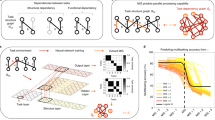Abstract
Iterative learning (\(\textbf{It}\)-learning) is a Gold-style learning model in which each of a learner’s output conjectures may depend only upon the learner’s current conjecture and the current input element. Two extensions of the \(\textbf{It}\)-learning model are considered, each of which involves parallelism. The first is to run, in parallel, distinct instantiations of a single learner on each input element. The second is to run, in parallel, n individual learners incorporating the first extension, and to allow the n learners to communicate their results. In most contexts, parallelism is only a means of improving efficiency. However, as shown herein, learners incorporating the first extension are more powerful than \(\textbf{It}\)-learners, and, collective learners resulting from the second extension increase in learning power as n increases. Attention is paid to how one would actually implement a learner incorporating each extension. Parallelism is the underlying mechanism employed.
Preview
Unable to display preview. Download preview PDF.
Similar content being viewed by others
References
Arikawa, S., Miyano, S., Shinohara, A., Kuhara, S., Mukouchi, Y., Shinohara, T.: A machine discovery from amino-acid-sequences by decision trees over regular patterns. New Generation Computing 11, 361–375 (1993)
Angluin, D.: Finding patterns common to a set of strings. Journal of Computer and System Sciences 21, 46–62 (1980)
Brazma, A., Ukkonen, E., Vilo, J.: Discovering unbounded unions of regular pattern languages from positive examples. In: Nagamochi, H., Suri, S., Igarashi, Y., Miyano, S., Asano, T. (eds.) ISAAC 1996. LNCS, vol. 1178, Springer, Heidelberg (1996)
Case, J.: Periodicity in generations of automata. Mathematical Systems Theory 8, 15–32 (1974)
Case, J.: Infinitary self-reference in learning theory. Journal of Experimental and Theoretical Artificial Intelligence 6, 3–16 (1994)
Carlucci, L., Case, J., Jain, S., Stephan, F.: Memory-limited U-shaped learning. In: Lugosi, G., Simon, H.U. (eds.) COLT 2006. LNCS (LNAI), vol. 4005, pp. 244–258. Springer, Heidelberg (2006)
Case, J., Jain, S., Kaufmann, S., Sharma, A., Stephan, F.: Predictive learning models for concept drift. Theoretical Computer Science, Special Issue for ALT 1998, 268, 323–349 (2001)
Case, J., Jain, S., Lange, S., Zeugmann, T.: Incremental concept learning for bounded data mining. Information and Computation 152, 74–110 (1999)
Case, J., Lynes, C.: Machine inductive inference and language identification. In: Nielsen, M., Schmidt, E.M. (eds.) Automata, Languages, and Programming. LNCS, vol. 140, pp. 107–115. Springer, Heidelberg (1982)
Case, J., Moelius, S.E.: U-shaped, iterative, and iterative-with-counter learning. In: COLT 2007. LNCS(LNAI), vol. 4539, pp. 172–186. Springer, Berlin (2007)
Case, J., Moelius, S.E.: U-shaped, iterative, and iterative-with-counter learning (expanded version). Technical report, University of Delaware (2007), Available at http://www.cis.udel.edu/~moelius/publications
Davis, M., Sigal, R., Weyuker, E.: Computability, Complexity, and Languages, 2nd edn. Academic Press, London (1994)
Fulk, M., Jain, S., Osherson, D.: Open problems in Systems That Learn. Journal of Computer and System Sciences 49(3), 589–604 (1994)
Gold, E.: Language identification in the limit. Information and Control 10, 447–474 (1967)
Jain, S., Osherson, D., Royer, J., Sharma, A.: Systems that Learn: An Introduction to Learning Theory, 2nd edn. MIT Press, Cambridge (1999)
Kilpeläinen, P., Mannila, H., Ukkonen, E.: MDL learning of unions of simple pattern languages from positive examples. In: Vitányi, P.M.B. (ed.) EuroCOLT 1995. LNCS, vol. 904, pp. 252–260. Springer, Heidelberg (1995)
Lange, S., Wiehagen, R.: Polynomial time inference of arbitrary pattern languages. New Generation Computing 8, 361–370 (1991)
Lange, S., Zeugmann, T.: Incremental learning from positive data. Journal of Computer and System Sciences 53, 88–103 (1996)
Nix, R.: Editing by examples. Technical Report 280, Department of Computer Science, Yale University, New Haven, CT, USA (1983)
Osherson, D., Stob, M., Weinstein, S.: Systems that Learn: An Introduction to Learning Theory for Cognitive and Computer Scientists. MIT Press, Cambridge (1986)
Rogers, H.: Theory of Recursive Functions and Effective Computability. MIT Press, Cambridge (1967) (reprinted, MIT Press, 1987)
Shinohara, T., Arikawa, A.: Pattern inference. In: Lange, S., Jantke, K.P. (eds.) Algorithmic Learning for Knowledge-Based Systems. LNCS, vol. 961, pp. 259–291. Springer, Heidelberg (1995)
Salomaa, A.: Patterns (The Formal Language Theory Column). EATCS Bulletin 54, 46–62 (1994)
Salomaa, A.: Return to patterns (The Formal Language Theory Column). EATCS Bulletin 55, 144–157 (1994)
Shinohara, T.: Inferring unions of two pattern languages. Bulletin of Informatics and Cybernetics 20, 83–88 (1983)
Shimozono, S., Shinohara, A., Shinohara, T., Miyano, S., Kuhara, S., Arikawa, S.: Knowledge acquisition from amino acid sequences by machine learning system BONSAI. Trans. Information Processing Society of Japan 35, 2009–2018 (1994)
Wiehagen, R.: Limes-erkennung rekursiver funktionen durch spezielle strategien. Electronische Informationverarbeitung und Kybernetik 12, 93–99 (1976)
Winskel, G.: The Formal Semantics of Programming Languages: An Introduction. In: Foundations of Computing Series, MIT Press, Cambridge (1993)
Wright, K.: Identification of unions of languages drawn from an identifiable class. In: Rivest, R., Haussler, D., Warmuth, M. (eds.) Proceedings of the Second Annual Workshop on Computational Learning Theory, Santa Cruz, California, pp. 328–333. Morgan Kaufmann, San Francisco (1989)
Author information
Authors and Affiliations
Editor information
Editors and Affiliations
Rights and permissions
Copyright information
© 2007 Springer-Verlag Berlin Heidelberg
About this paper
Cite this paper
Case, J., Moelius, S.E. (2007). Parallelism Increases Iterative Learning Power. In: Hutter, M., Servedio, R.A., Takimoto, E. (eds) Algorithmic Learning Theory. ALT 2007. Lecture Notes in Computer Science(), vol 4754. Springer, Berlin, Heidelberg. https://doi.org/10.1007/978-3-540-75225-7_8
Download citation
DOI: https://doi.org/10.1007/978-3-540-75225-7_8
Publisher Name: Springer, Berlin, Heidelberg
Print ISBN: 978-3-540-75224-0
Online ISBN: 978-3-540-75225-7
eBook Packages: Computer ScienceComputer Science (R0)




